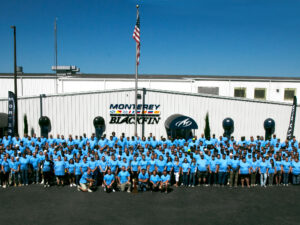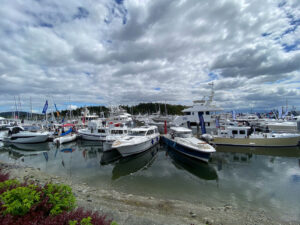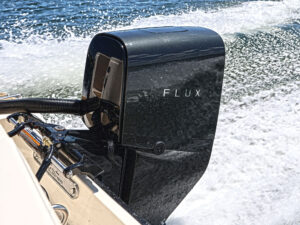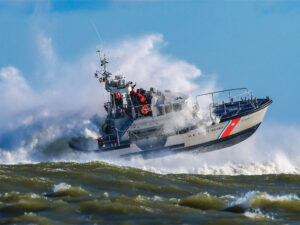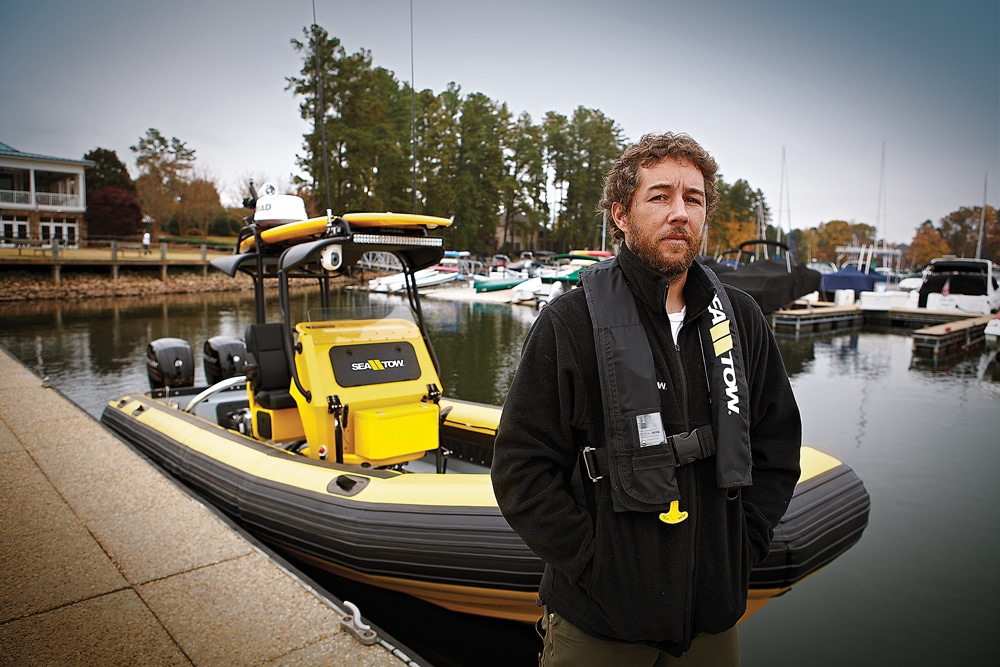
The Ultimate Boat
What kind of boat would you want if your job depended on it? What if other people’s boats depended on it? What about, sometimes, even other people’s lives? These are the questions that Ryan Pratt, who owns the Sea Tow franchise in Stuart, Florida, had running through his head when he purchased a Willard 370 RIB from a government auction. He took that hull and decided to see if he could rebuild it into the ultimate towing machine, adding several intriguing components to make his boat better and his job easier. Take a look at the boat and everything Pratt installed. If they work for him, then just maybe they could work for you too.
Heavy Duty, Rock and Roll
Pratt has been a licensed captain for 15 years, and four years ago he decided to buy the Sea Tow franchise in Stuart. The first thing he did was start looking for rugged boats that could handle heavy workloads in rough seas. He started going to government surplus auctions and buying 24-foot RIBs.
“I always thought RIBs were the best boats out there,” said Pratt. “The tubes act as training wheels in rough conditions or when towing.”
The Willard Sea Force 730 hull (willardmarine.com) has a constant 24-degree deadrise, giving it a sharp wave-slicing entry and running surface. As the boat pounds on re-entry in rough seas, the inflatable collar acts like an air bag, absorbing most of the impact. When in beam seas, the collar also builds in a natural five- or six-second delay in the rolling motion, providing the captain time to correct it at the helm.
The original hull had a sterndrive, so Pratt had to reconfigure the transom for outboard duty. Because RIBs are so light in the bow, a traditional outboard bracket wouldn’t work, because it would cause the boat to squat. So Pratt crafted a bracket that matches the boat’s running surface, extending it 32 inches aft. That bracket provides an additional 800 pounds of buoyancy to handle the twin outboard installation.
Check out what else Pratt added on to make his RIB the ultimate boat.
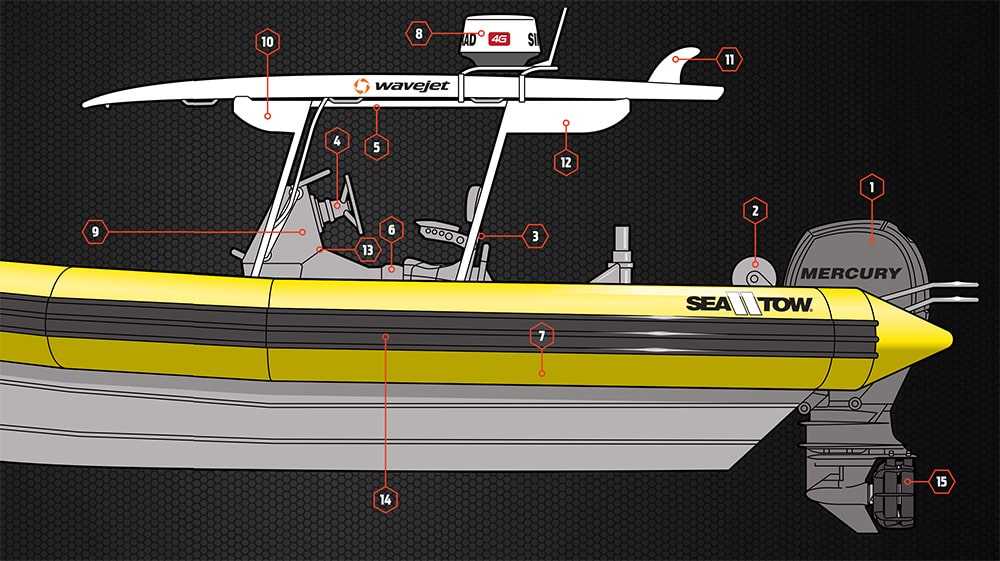
The Ultimate Boat
mercurymarine.com 2. Novabraid Spectra Synthetic Line
novabraid.com 3. Shockwave ICE2 Console
shockwaveseats.com 4. Optimus 360 Steering System
seastarsolutions.com 5. David Clark Series 9900 Wireless Intercom Headsets
davidclark.com 6. Marine Rescue Technologies 406 Local Emergency Receiver
marinerescuetechnologies.com 7. Marine Rescue Technologies Markus MOB Rescue Net
marinerescuetechnologies.com 8. Simrad Broadband 4G Radar
simrad-yachting.com 9. XM WX Marine Weather
xmwxweather.com/marine 10. FLIR MD-Series Fixed-Mount Night Vision
flir.com 11. WaveJet Propulsion Rescue Board
wavejet.com 12. Rigid Industries LED Lights
rigidindustries.com 13. Blue Sea Systems ML-Series Remote Battery Switches
bluesea.com 14. CPI Marine Air Collar
cpitx.com 15. Marine Propulsion Technologies Thrusters
mptmfg.com Boating Magazine
Twin Mercury 150 FourStroke Outboards
The reason for twin engines is obvious. “We sometimes run 60 miles offshore to help customers,” Pratt said. “We need to make sure we can bring them back.”
But why the Mercs? Pratt wanted four strokes with a lot of displacement, and the Merc 150s are three-liter blocks. “With these engines you’re running light most of the time,” he said, which means a lot less wear and tear over the long haul. They also have great low-end torque, excellent for towing big vessels and taking on heavy workloads. The Mercs also have QR codes placed on the engines for maintenance help. If you need to change the oil, scanning the code leads to a step-by-step YouTube video.
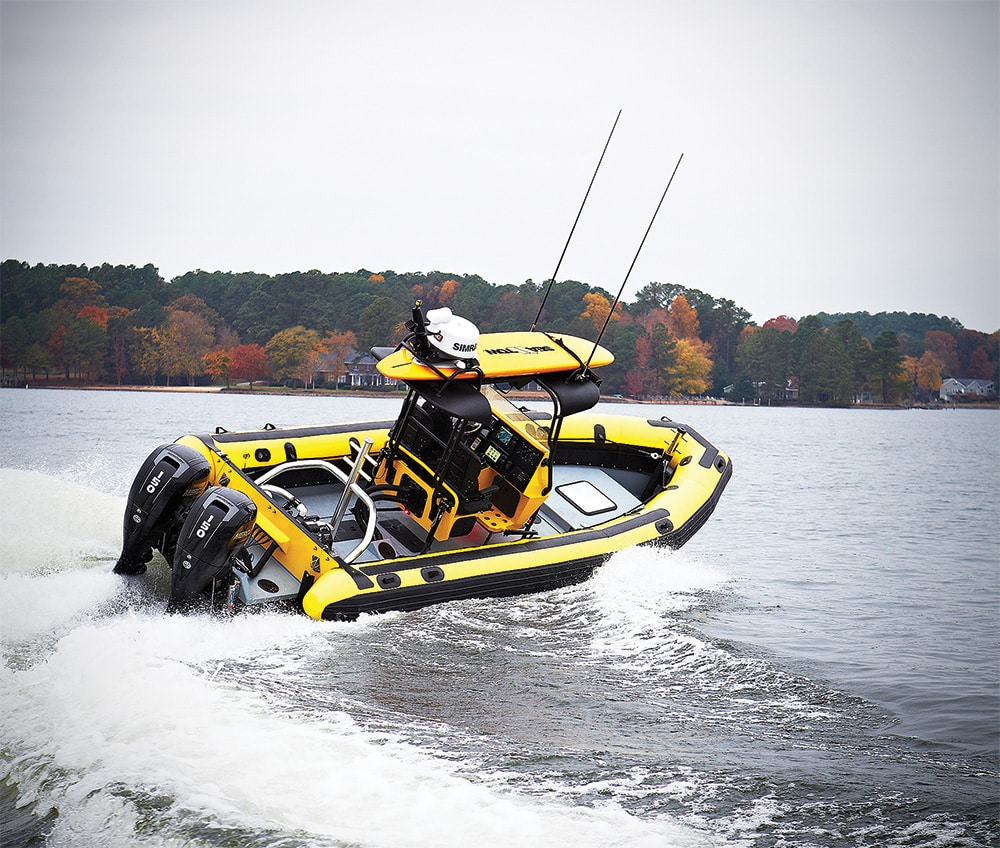
The Ultimate Boat
Novabraid Spectra Synthetic Line
This synthetic line has little to no stretch, which makes it ideal for towing. Line that stretches develops a lot of tension, and should it break, that energy is often redirected back at the tow boat — with dangerous consequences. Low-stretch synthetic line tends to fall into the water if it breaks. It also floats, so it’s less likely to tangle in the props.
Plus, it’s about a quarter of the diameter of similar-strength traditional rope. With the small diameter, Pratt can load a lot more onto his boat. That length comes in handy when pulling boats from low-water situations or if one should get stuck in the surf line, allowing Pratt to keep his boat out of danger.
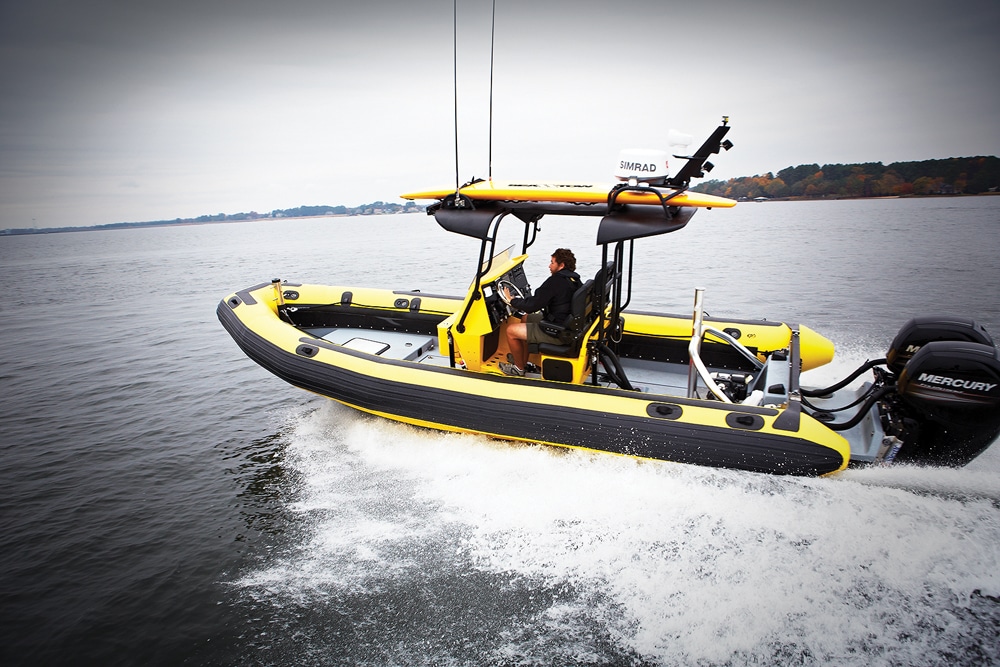
The Ultimate Boat
Shockwave ICE2 Console
The ICE2 is a console setup built on a three-axis suspension system. It’s a full helm with seats built on a Fox shock absorber that’s mounted 12 inches above the deck as a single unit. The pad can move 12 inches forward or aft and 6 inches side to side, and is designed to decelerate each impact.
“Going 30 knots in 6-foot seas for long stretches, I can still walk when I get back to the dock,” he said.
On a normal boat, as you impact off a wave, your body weight carries forward and pushes the throttles, so you fight a constant battle to maintain speed and course. Also, you have to slow down to work the GPS or the radio, which wastes search time and also wears on the engines. With the ICE2 helm, Pratt can keep the throttles smooth and work the GPS, chart plotter and VHF while on plane.
Optimus 360 Steering System
The Optimus 360 steering system by SeaStar Solutions brings joystick steering to outboard boats. With it, Pratt can steer side to side and rotate the boat 360 degrees on its axis with pinpoint control. It aids in close-quarters docking situations, around slips and at the launch ramp. It also helps Pratt bring towed vessels back into port. “Once we get into close quarters we pull the vessel alongside in what’s called a hip tow,” he said. It’s hard for a single operator on a 24-foot boat to handle a 50-footer that needs to be backed into its slip or tied off in tight confines at a yard. For hip towing, Pratt employs boost mode, which increases rpm, to improve response time.
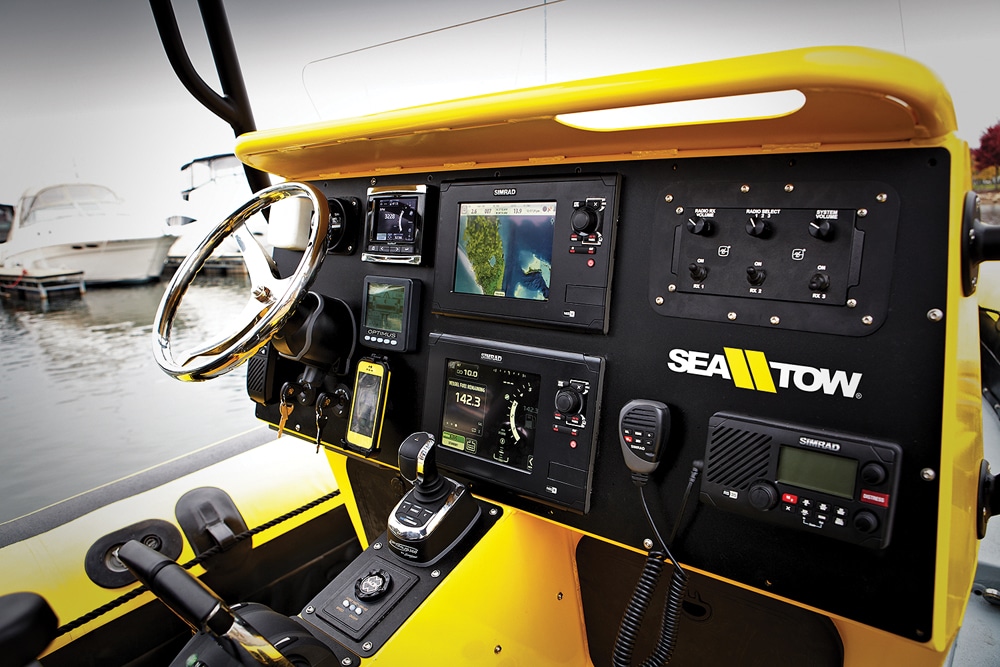
The Ultimate Boat
David Clark Series 9900 Wireless Intercom Headsets
When running at full speed, or even just on plane, wind noise and vessel vibration can make it hard to communicate over a VHF or cellphone. To talk to a distressed owner or the U.S. Coast Guard, Pratt would have to slow down. These noise-canceling headsets integrate the two VHF radios on board along with a cellphone, so Pratt can monitor and use all three at the same time while running at speed.
Marine Rescue Technologies 406 Local Emergency Receiver
When a vessel in distress activates an EPIRB, the signal goes to a central response service that first verifies it and then sends it to the appropriate local authorities. Response times can take anywhere from 30 minutes to two hours. This receiver displays any EPIRB signal within 25 miles of Pratt’s chart plotter, so he can quickly respond.
Marine Rescue Technologies Markus MOB Rescue Net
When needed, Pratt can quickly roll this bagged 4-foot net over the gunwale. If someone is man overboard, he or she can grab onto it until the crew can assist, or, if needed, it can be used to roll him into the boat over the gunwale.
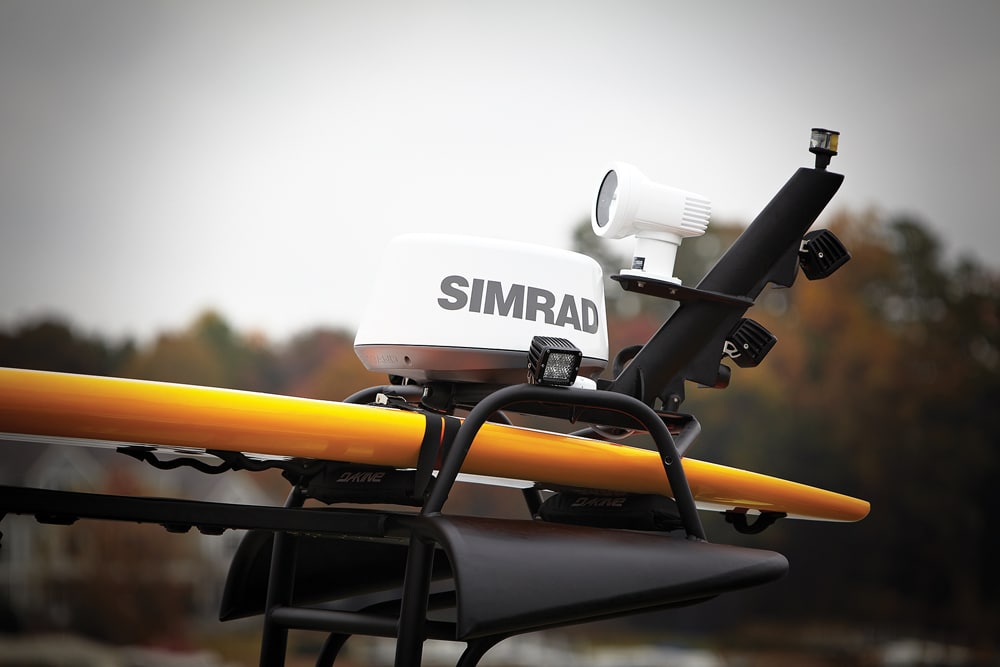
The Ultimate Boat
Simrad Broadband 4G Radar
This unit is ideal for small boats because of its small, low-emission radome that produces high-quality returns on-screen. It operates at ranges from 219 yards to 36 nautical miles. “A lot of times when people call us, they really don’t know where they are,” Pratt said. “The 4G radar helps us lock in on them.”
The Simrad 4G also has MARPA (mini-automatic radar plotting aid) that can track up to 20 vessels on-screen simultaneously. If there’s a lot of traffic in a specific area, this helps Pratt determine which might be in distress. For example, if he locks on four targets and three are moving while one is not, he knows to lock in on the relatively stationary boat.
Pratt runs his navigational electronics through two Simrad NSS8 multifunction displays.
XM WX Marine Weather
Pratt overlays the XM satellite weather map onto his radar and chart plotter so he can closely follow any fronts or storm systems in the vicinity. One key function is the current speed and direction. “Say there’s a 6-knot north current,” Pratt said. “If we have a long run to a vessel, we can adjust our course according to the currents.”
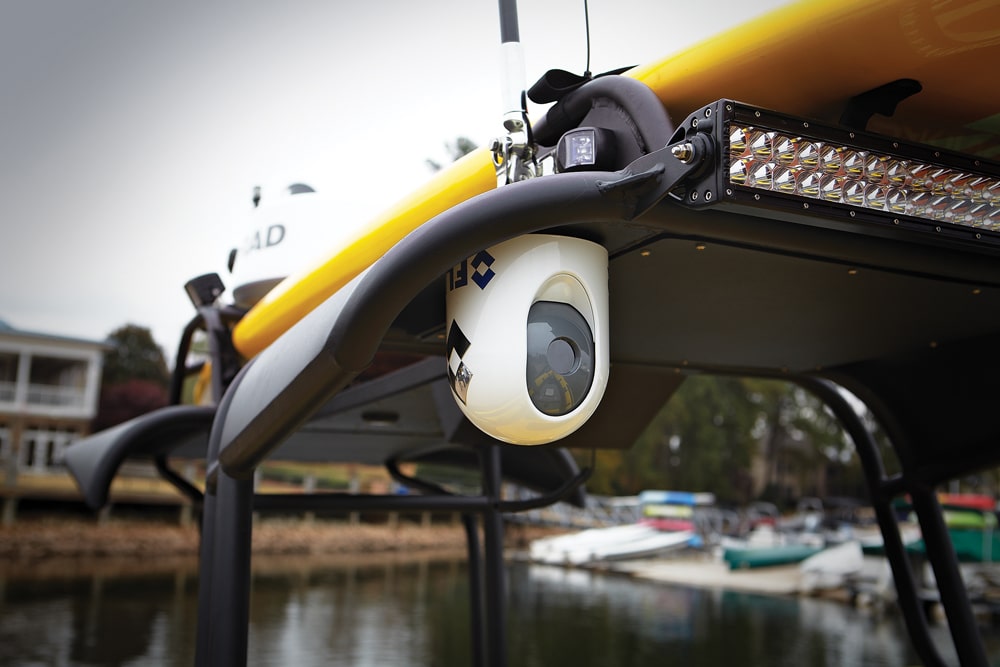
The Ultimate Boat
FLIR MD-Series Fixed-Mount Night Vision
With this thermal technology, Pratt can find a broken-down vessel at night by scanning an area to pick up its heat signature. It’s also great for finding channel markers and inlet jetties without needing a vision-ruining spotlight.
WaveJet Propulsion Rescue Board
Pratt carries the 11-foot-long rescue board on his hardtop. There’s a battery-powered jet propulsion pod mounted to the bottom of the board that can power it along at 2 to 4 knots.
The RIB has a 24-inch draft, so Pratt uses the board to run a tow line to people who’ve run aground or boats stranded on the beach, keeping his boat safely out in deeper water.
Rigid Industries LED Lights
The rugged aluminum housing is treated with both a corrosion inhibitor and a UV-resistant powder coating. The lenses are scratch-resistant polycarbonate, and the mounting hardware is stainless steel. Pratt also has waterproof LEDs mounted on his trailer bunks to make it easier at the ramp at night.
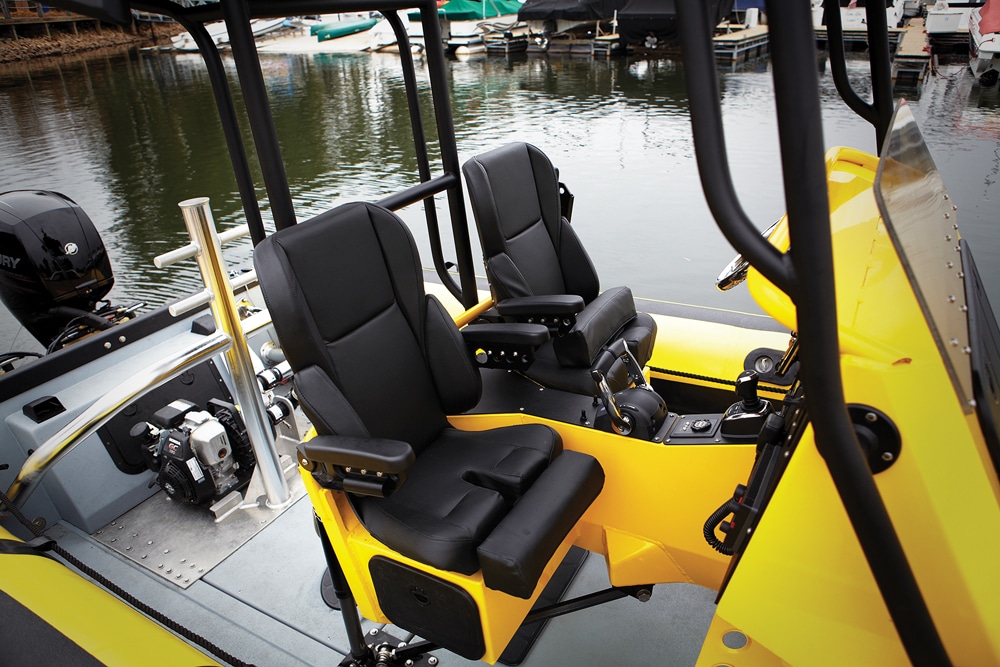
The Ultimate Boat
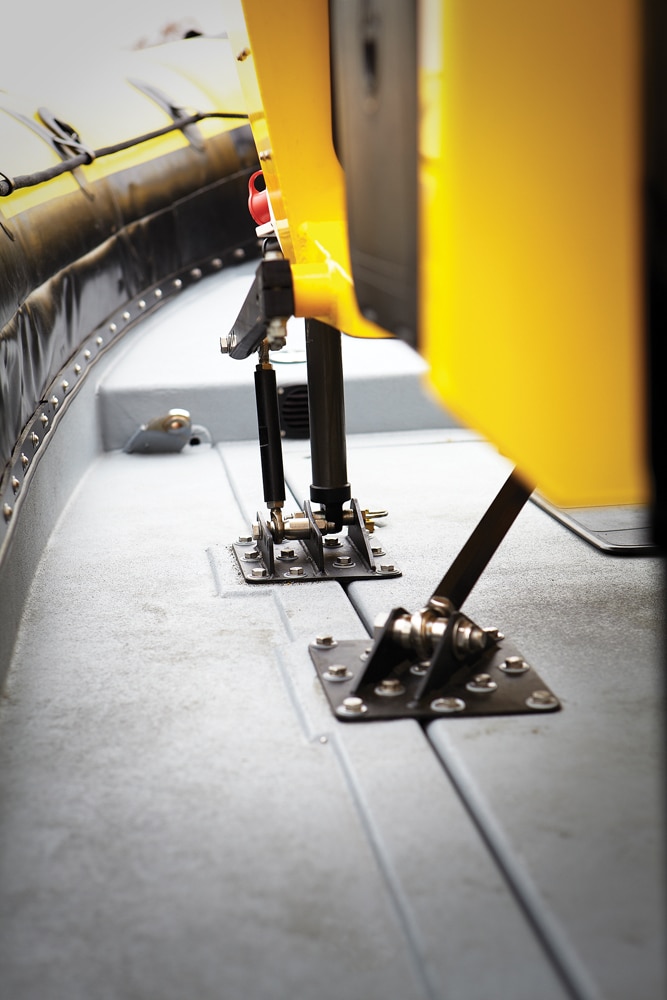
The Ultimate Boat
Blue Sea Systems ML-Series Remote Battery Switches
These install on the dash like rocker switches, giving fingertip control of the battery switches from the helm. They also have a manual override so you can use the traditional battery switches if needed.
Pratt also installed DeckHand Dimmers that control the brightness of his onboard lights so he can adjust from barely visible to full power as needed.
CPI Marine Air Collar
The heavy-duty polyurethane collar has better UV resistance than PVC tubing and is more puncture-resistant than hypalon. The collar uses removable air bladders for inflation, so if one gets punctured, it is easy to remove it and replace with a spare. The bladders can be swapped out on water, so Pratt can do a fast repair at sea if needed and still get home safely.
Marine Propulsion Technologies Thrusters
These look like prop guards, but they contain a system of nozzles and venturi ports that flow clean water to the propellers so they get good bite in all conditions, significantly decreasing cavitation at high rpm or in rough seas. The cone-shaped units also increase directional thrust, which improves performance. In flat seas the additional drag could scrape 5 percent off their efficiency, but in any other sea conditions the improved water flow will boost efficiency.
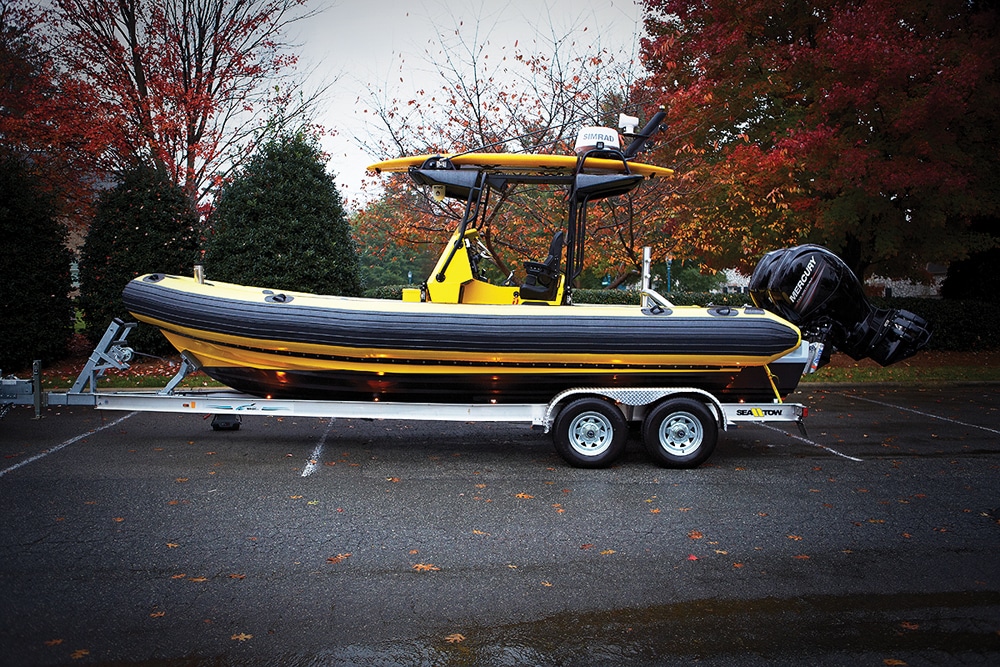
The Ultimate Boat
Magic Tilt Trailer
Pratt took his Willard 730 over to the Magic Tilt complex in Clearwater, Florida, and the company built him a custom aluminum trailer. Magic Tilt’s builders suspended Pratt’s boat in the air and built the trailer underneath it so that it perfectly matches his hull. The custom fit makes it extremely easy to launch and load the boat. Magic Tilt also built stairs on the front of the tongue to make it easy to enter and exit the boat on the trailer. All this combines to make it fast and easy for a single person to launch the boat, which is critical for a Sea Tow operator like Pratt to quickly reach his customers.

